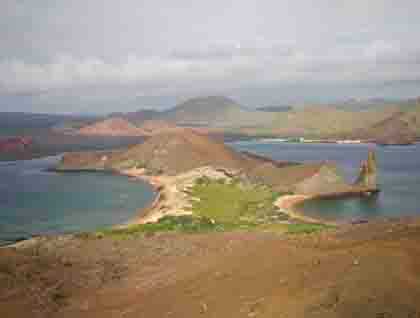Located on the Southern part of Santiago, Bartolomé Island is one of the smallest in the archipelago, but it is one of the most visited places for its amazing volcanic landscapes. The view from the summit is spectacular with the possibility to see several of the main islands and pinnacle rock, which is one of the most famous landscapes in the Galapagos. Early in the morning, just before sunrise, we began our activities landing on the small dock just beside the wooden steps that lead to the top of the island. With the mission to get the summit of Bartolome, we began to hike, enjoying the view with the first beams of sun and refreshing winds. Like old snapshots taken thousands of years ago, petrified lava flows showed us the volcanism and the geology of Galápagos. Spatter cones, tuff cones, sunken volcanoes and lava tubes were right there in front of our eyes, giving our guests living examples of how volcanic archipelagos are created.
After breakfast we headed back to the island to snorkel and swim from the golden beach, which lays just at the foot of the pinnacle rock. We had excellent weather conditions with calm and clear waters, so our guests had chance to observe sting rays, colorful tropical fish, white-tip reef sharks, stingrays and blue footed boobies in a feeding frenzy. In the afternoon we sailed west for about two hours to continue our exploration at Rábida Island. In the distance it looked higher than Bartolome with green vegetation and a unique red sandy beach, which is due to its high concentration of oxidized iron. Our guests had different activities to begin this afternoon; the first group with kayakers, the second with deep water snorkelers and the third with off-shore snorkeling and relaxing on the red beach. The underwater adventure was great, for we saw white-tipped reef sharks, Pacific green sea turtles and hundreds of sea stars among many other great sightings. Those on the kayaking outing enjoyed the spectacular view of the sheer volcanic landscape as well as marine iguanas swimming, brown pelicans trying to catch some fish and along the trees, finches and mockingbirds fluttered demonstrating their happiness due to the first rainfalls. Fresh water is a blessing after a very long dry season.
As soon we finished the visit to Rábida, the National Geographic Islander sailed north with the mission to observe the eruption of Wolf volcano in Isabela Island which began some days ago along the east flank of the volcano. After three hours we crossed the Equator and Lynn, our Expedition Leader, made an announcement to inform us we were approaching to the place where this geological event was taking place. From the external decks we observed different vents from where the lava flowed down; some vents were near to the summit of the main volcano and others near to the ocean, but all of them connected to each other by rivers of lava that flowed incandescent, producing explosions when contacting the ocean. The full moon helped us to observe the steam flowing from the seashore and sometimes we heard the noise of huge rocks collapsing from the mountain. After hours of enjoying the magnificence of nature, we finally continued sailing northwest to the opposite side of Wolf volcano. It was a great day visiting incredible places with surprises that stunned us. We were able to witness how nature works in this beautiful place called Galapagos.







